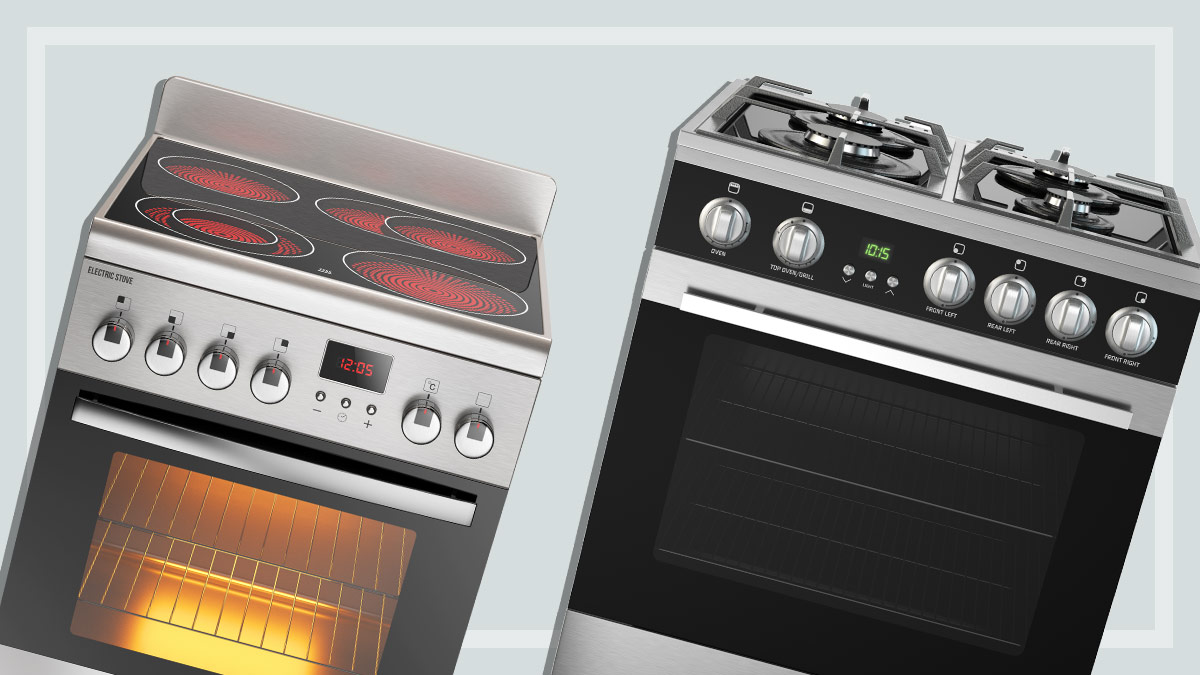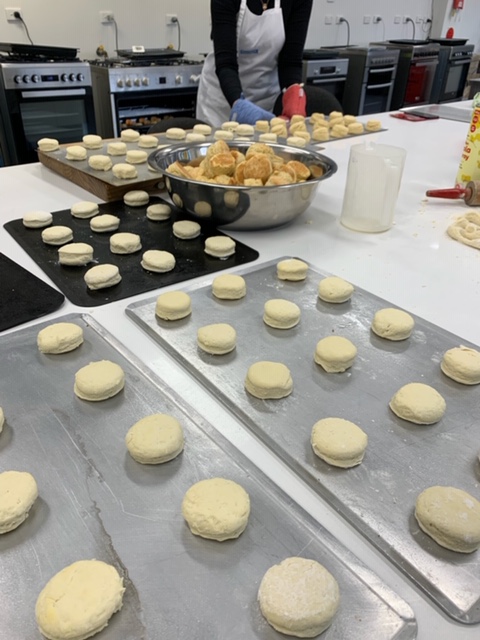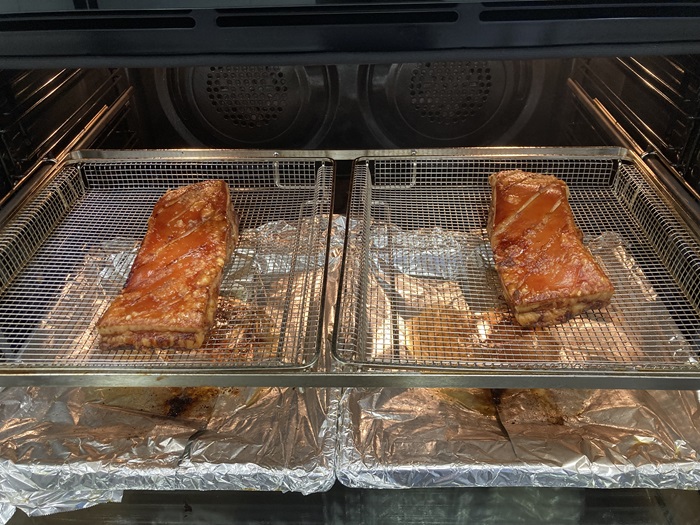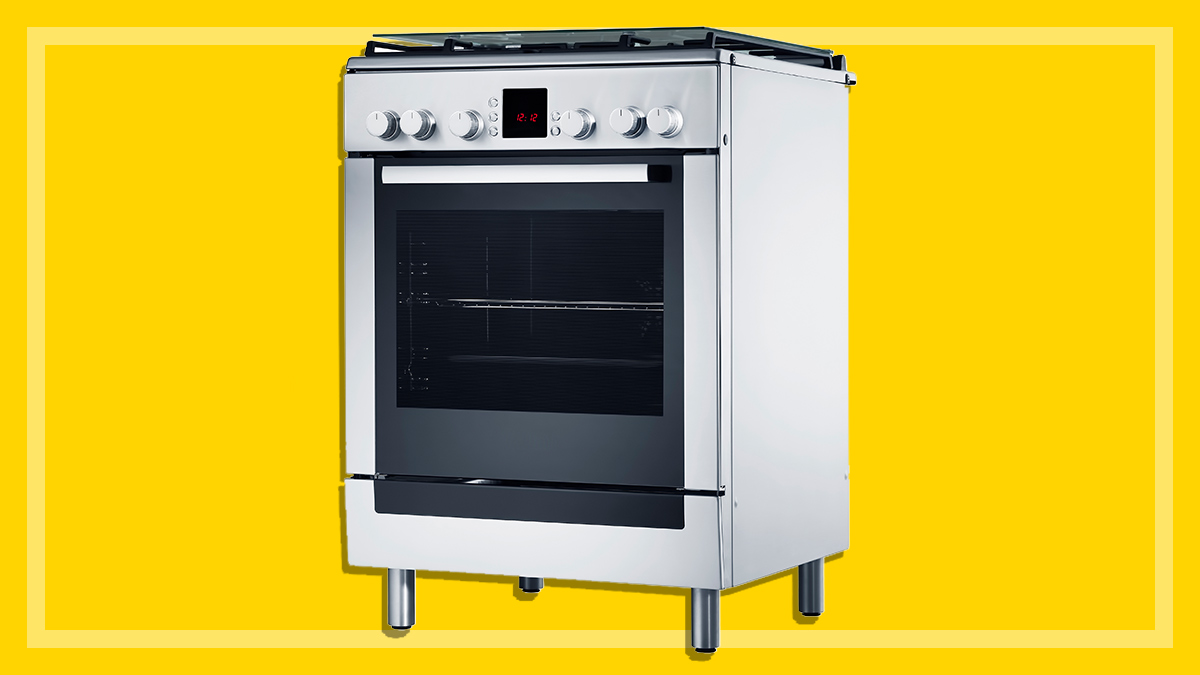Get our independent lab tests, expert reviews and honest advice.
How to choose a freestanding oven

A freestanding oven can be a real showstopper in your kitchen. Whether you’re replacing an old unit or revamping your kitchen, you’ll be sure to find the right style and width to fit into any space in your cabinetry.
On this page:
- What is a freestanding oven?
- What you need to consider
- How much do they cost?
- What size do you need?
- What to check before buying: Cooktop
- Essential oven functions
What is a freestanding oven?
A freestanding oven (also known as a stove, range or cooker) is an oven and cooktop combined into one standalone unit. They’re commonly available in 60cm and 90cm sizes and any configuration goes – you can have electric or gas oven, combined with a gas, induction or ceramic hob.
Freestanding ovens are suitable for large families and people who like to bake – the large internal space of the 90cm models is their biggest selling point. The ability to simultaneously roast two large turkeys, a tray of vegies and even a dessert at Christmastime would be the deciding factor for many keen cooks.
What you need to consider
While the size of the larger freestanding ovens may be appealing to some home cooks, it can also be a drawback. The shelves and baking trays are significantly wider than those of a standard oven and can be difficult to handle – particularly when loaded with hot food. Being so wide, they’re also difficult to clean in a domestic sink.
The larger capacity also means preheat times can be longer – on average freestanding ovens take 20 minutes to heat to 250°C. And we’ve found that some never quite reach their maximum heat setting on higher temperatures, so the pre-heat light is always on.
In contrast with wall ovens, you’ll need to bend down to access the baking trays, or get on your hands and knees to clean the oven
In contrast with wall ovens, you’ll need to bend down to access the baking trays, or get on your hands and knees to clean the oven (even with a pyrolytic option, as you still have to wipe it out).
Choose one that has a fingerprint-resistant stainless steel exterior, or better yet, an easy-to-clean enamel coating. Look for a self-cleaning feature such as catalytic liners with good coverage or a pyrolytic function.
If you choose the gas cooktop option for your range, don’t forget the heavy cast iron trivets and all the burner parts that need to be maintained. A ceramic or induction cooktop makes cleaning easier.
How much do they cost?
Freestanding ovens generally have a large range when it comes to price. The models we tested range from $599 all the way up to $11,998 (and you can find models that cost even more).
Price generally depends on how many bells and whistles the model has and the calibre of craftsmanship. When it comes to performance, all of the top scoring models in our freestanding ovens test cost more than $3000.
You may also need to factor in the cost of potential upgrades or modifications to your home’s electrical wiring and switchboard. Freestanding ovens can draw a lot more power than built-in ovens, especially those models with induction cooktops and pyrolytic cleaning.
It’s a good idea to contact a qualified electrician before buying one to check your home’s electrical capacity and if any modifications are required.
What size do you need?
60cm-wide models
These units are a common size and suit most kitchens. They typically have four cooking zones or burners, but only three out of four pots fit comfortably – there can be restricted access to some burners due to the smaller surface area. They either have a gas or electric oven that can include simple function settings, right up to all the multi-function settings you could possibly need.
90cm-wide models
Also quite popular are the 90cm multi-functional models with an all-in-one combined grill and fashionable, commercial stainless steel look.
Or there’s the old world charm of the enamel-coated traditional cookers available in an array of colours with old-fashioned fittings. They come in one-, two- or three-door ovens, usually with a separate grill, smaller main oven and a tall oven.
These ovens may be a case where appealing aesthetics triumph over optimum functionality. As impressive as they look, they can be expensive. These ranges have either five or six hotplates/burners with the option of flexi zones or fish burners.
70–80cm and 120–150cm-wide models
These sizes aren’t as common. The extra width of the largest models allows for more baking space in the oven and more cooktop surface so there’s less crowding, with possibly five or six burner or cooking zone arrangements. The 120cm and 150cm models usually have two ovens of different capacities and include extra cooking zones that allow for more versatility to accommodate char-grill plates, Teppanyaki and simmer plates.
What to check before buying: Cooktop
Controls and labels
These should be a good size, clearly labelled and easy to use. They should be easy to grip with a clear pointer. Removable controls help when it comes to cleaning. Controls positioned at the front mean your splashback can run across the whole back wall. It looks good, but the controls will be easy for young children to reach. Etched labels (as opposed to bonded labels) on stainless steel surfaces won’t rub off over time.
Cooking zones / burners
Look for a layout that’s well-spaced and includes a range of simmer, medium and large cooking zones/burners. Simmer and wok burners should be at the front so you don’t have to lean over other burners to stir a sauce or stir-fry. When simmering foods that don’t need frequent stirring, such as casseroles, you’d normally use a medium-sized burner; these are best positioned at the back.
Cookware
It should fit comfortably over the cooking zone and not restrict the use of the other zones. If you’ve chosen an induction cooktop, make sure the cookware is compatible.
Residual heat warning light for ceramic / induction cooktops
This is a useful safety mechanism that stays on until the cooktop has returned to a safe temperature.
Automatic switch-off
This is another useful safety mechanism. If a heat setting is not set for a cooking zone within a certain time after you turn on the cooktop, it will automatically switch itself off. This will also happen if a heat setting has been selected but no contact has been made with a pot on the element.
What to check before buying: Oven
Internal space
Take the measurements of your largest baking dish to the store rather than trusting the stated capacity. Manufacturers measure usable capacity differently, so they can’t be compared across brands.
As part of the tests for our oven reviews we generally take three measurements:
- from the deepest shelf or tray in the lowest shelf position to the grill element
- side wall to side wall (at the narrowest point to fit the widest possible tray)
- rear wall to the door.
In many cases you can slide a wide dish in between the shelf supports. Using the oven floor is not recommended in these ovens.
Gas or electric
You can choose from a gas or electric oven, but the majority are electric and this type dominates the market. It’s why we don’t currently review gas oven options.
Shelves
Shelves should have safety stops to prevent them from being pulled out accidentally, and should not tilt when pulled out with a load. Look for a good range of shelf positions and three or more shelves/trays.

Telescopic shelf runners
These help to keep the shelf stable and make it smoother to slide shelves in and out, though they’re not usually an included feature.
Grill tray
This should slide in and out easily and allow you to place food at the back. Look for a safety stop so it doesn’t pull right out. A smokeless grill tray traps fat and grease below it, rather than under a wire rack. Many models lack this feature but this is important as spattering and smoking fat can be messy.
Grill element
This should be set high into the ceiling or have a shield so it can’t be accidentally touched. It should also drop down for cleaning the oven ceiling.
Separate grill area
This means you can cook in the main oven and grill at the same time.
Window
This should be large enough for a clear view of all shelves inside, including the top shelf.
Storage tray
This is a handy storage space in some freestanding ovens where you can keep your baking trays.
Adjustable legs
You should be able to adjust the height of your oven to match the height of your benchtop, and for levelling.
Essential oven functions
It’s important that your oven has:
- a smokeless or anti-spatter grill tray, with a perforated plate rather than a simple wire rack (this helps stop the collected fat from spitting and flaring up)
- two oven shelves
- a baking tray.
And as long as your oven has the following features as a minimum, you’ll be good to tackle any baking tasks.
Fan-forced
This works well for multi-shelf cooking, reheating, pastries and roasts. It uses the fan with heat coming from the element surrounding it and generally heats up more quickly, evenly and efficiently.
Conventional or traditional
This uses heat from the top and bottom elements with no fan. It provides reasonably even heating, but tends to be slightly hotter towards the top, allowing food to brown on top. It’s ideal for single trays of biscuits, scones, muffins, slices and egg dishes like quiche or baked custards.
Fan-assist
This setting is ideal for foods that require a short cooking time and only use a maximum of two shelves. Heat comes from the top and bottom element with a fan that circulates the hot air.
Pizza mode
As the name suggests, pizza mode is ideal for pizzas and other dishes where browning on the base is required, like meat pies, fruit pies, focaccia and bread. It uses high heat and a combination of ‘base heat’ and fan or fan-forced where heat comes from the elements surrounding the fan as well as the bottom element. The pastry bake function is similar, using the fan and bottom element.
Fan grill
This uses the grill element and the fan. It’s ideal for large cuts of meat like roasts, or meats that require longer cooking times like chicken legs and sausages. It’s also great for baked vegetables and for browning and crisping the top of pasta and potato bakes.
Grill only
This uses heat from the grill element and is ideal for smaller, tender cuts of meat. Unless stated in the instructions, grill with the oven door closed and use one of the top two shelf positions.
Bottom element
This is an alternative to pizza mode where heat comes from the base element only. It’s also ideal for foods that require a crispy base, like pizza. Cook in the lower half of the oven when using this function, and use aluminium trays for even browning.
Optional functions to look for
Rapid heat
This setting uses heat from the elements surrounding the fan as well as the smaller element above the food. It allows you to preheat your oven quicker than you could in fan-forced mode. It’s also ideal for cooking frozen pre-packed foods, which can be placed straight into the oven from the freezer.
Defrost
This uses no heat, but rather air is circulated by the oven to defrost the food. This mode can also be used to raise yeast dough and to dry fruit, vegetables and herbs. However, to reduce the chance of bacteria growing on food at unsafe temperatures, we’d recommend defrosting food in the fridge or microwave.
Automatic cooking functions
Also known as assisted cooking functions, these include recipes that correspond with the information programmed in the oven. Simply follow the recipe and the oven will work out the operating mode, shelf position, cooking time and temperature.
Food probe
If you cook lots of meat and roasts, an oven with a food probe will help take the guesswork out of achieving tender, juicy meat. Simply insert the probe into the fleshiest part of the meat and select the desired temperature or degree of cooking. The oven will complete cooking once the temperature is reached.
Adjustable pre-set temperatures
These give you a useful indication of what temperature is best for the food type and function being used.
Rotisserie and spit roast functions
These allow you to cook meat continuously without having to turn and baste the food. The fat in the meat drips over the surface as the rotisserie spins.

Air fryer functionality
With air fryers continuing to rise in popularity as a must-have kitchen appliance, there’s no surprise that oven manufacturers are including this functionality in their new offerings. Air fryer functions use the top element with the fan-forced setting, and require high temperatures over 200°C. You’ll also need to place another shelf below the air fryer basket to catch crumbs and drips.
Manufacturers recommend air frying in the oven works best for single layer cooking – you won’t need to shake or turn the food as the basket allows heat flow throughout the oven. Depending on what you’re cooking, smoke can build up in the cavity and if you’re cooking fatty foods, grease can spatter throughout the oven, which can be a difficult chore when it comes time to clean.
You can cover meats in foil to avoid fat spatters during cooking, and we’d suggest lining baking trays with foil when using them as a drip tray to reduce cleaning.
Proving
This setting uses the lowest temperature and the top element, providing a warm, moist environment that’s perfect for proving yeast dough. Keep in mind any oven can prove dough by simply preheating to the lowest temperature and then turning it off. Place a bowl of water on the bottom and then put the dough on a shelf above, covered with a towel.
Keep warm
This maintains an oven temperature around 60–85°C to keep food warm without continuing to cook.
Slow cooking
This setting uses heat from the top and bottom elements and a low temperature, usually around 70–120°C. Use this function for gentle, slow cooking of seared, tender pieces of meat in ovenware without a lid.
Divider shelves
These can help separate an extra-large oven cavity into two separate spaces that can be operated simultaneously. For example, the top section operates as a grill, while the bottom section can be set to fan-forced.
Installation: Do you need an electrician?
As with any appliance, it’s important to follow the manufacturer’s instructions regarding installation. In the case of freestanding ovens, it’s a good idea to contact a qualified electrician before buying one. They can advise whether you have the right phase for the amount of power it will draw.
A qualified electrician can advise whether you have the right phase for the amount of power it will draw
With features like extra oven compartments and being able to run them all at the same time, pyrolytic cleaning, fast heat-up and induction cooktops, the power consumption increases. This may be more than your home circuitry can handle, in which case the oven will need to be hard-wired by a licensed electrician.
If your oven is gas or has a gas cooktop, a plumber is required to connect the regulator and it’s also a good idea for them to check that the burners are all adjusted to 1kPa.
Preparing your new oven for use
If you’ve just had your freestanding oven installed, it doesn’t mean it’s ready to use straight away. You may notice a smell from the oven interior. This is production residue and needs to be burnt off before you start cooking in your oven.
- Wipe out the oven with a damp cloth and dry well.
- Remove any baking trays and turn on the oven – fan-forced for 30 minutes on 180°C.
- Repeat for the top and bottom element – 30 minutes on 180°C.
- Then turn on the grill element and run on high for 30 minutes.
- Allow the oven to cool before wiping over with warm soapy water.
- Your oven is now ready for cooking.
Make sure your kitchen is well ventilated while burning off the oven – open windows and turn on any rangehoods and exhaust fans. You may notice smoke and a strong smell during this time, but there’s no need to be alarmed. Avoid directly inhaling the smoke and smell.
Using your freestanding oven efficiently
Sustainability Victoria provides some useful tips for using your oven and cooktop more efficiently to help reduce your energy consumption and cooking costs in the kitchen.
Minimise heat loss
When using your oven, check the seals and hinges to make sure they’re working properly to seal the oven. Minimise opening the door during cooking, too – each time you open the door there’s heat loss, resulting in more energy needed to get the oven back to temperature again.
Consider oven capacity
If you have the space in your oven and you’re cooking multiple dishes, pop them in all at once rather than cooking in batches. Alternatively, if you have a 90cm oven and you’re only cooking one dish, consider if that meal can be cooked in an electric frypan, slow cooker, multi-cooker, air fryer or microwave, as smaller appliances use less energy than an oven and in some cases will even cook your food quicker too.
Efficient use of cooktop
When using your cooktop make sure your pans have a flat base to ensure better contact with the cooktop and better heat transfer. It’s also important to use the right-sized cooking zone to match the cookware you’re using – pots and pans should cover the entire cooking zone to minimise heat loss.
Disposing of your old oven
If you’re replacing your freestanding oven it’s important to get rid of your old one responsibly. Metal, plastic and other components can be recycled and kept out of landfill. Contact your local council to find out the best way to recycle your old white goods. Alternatively, you can search on Planet Ark to find a recycler near you.






